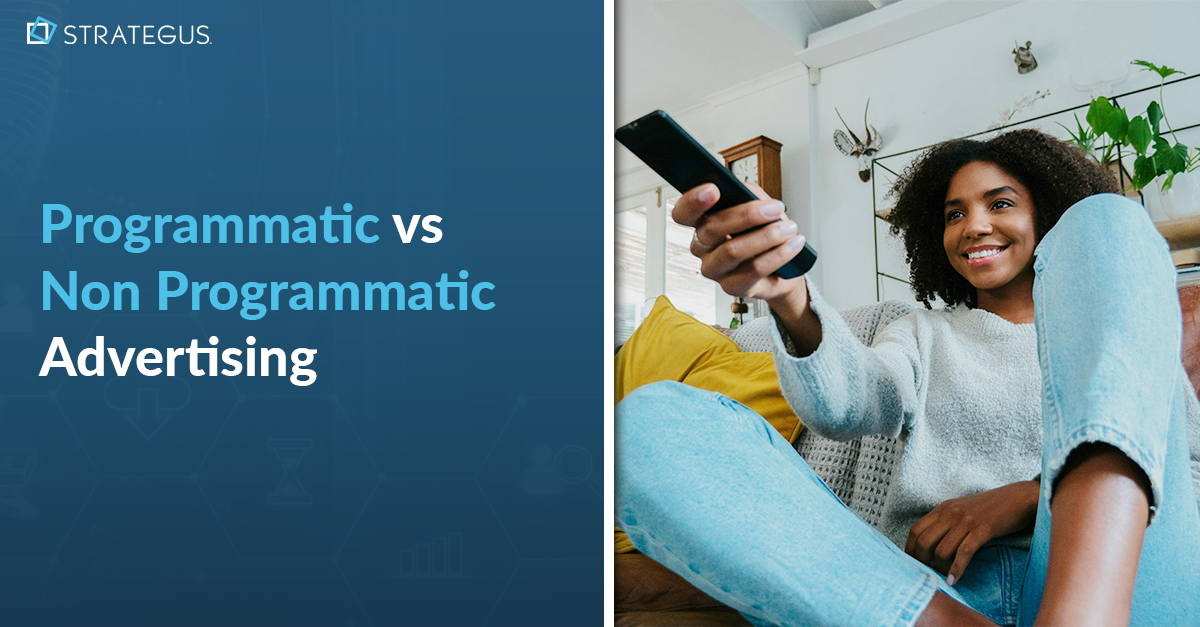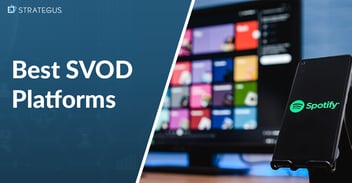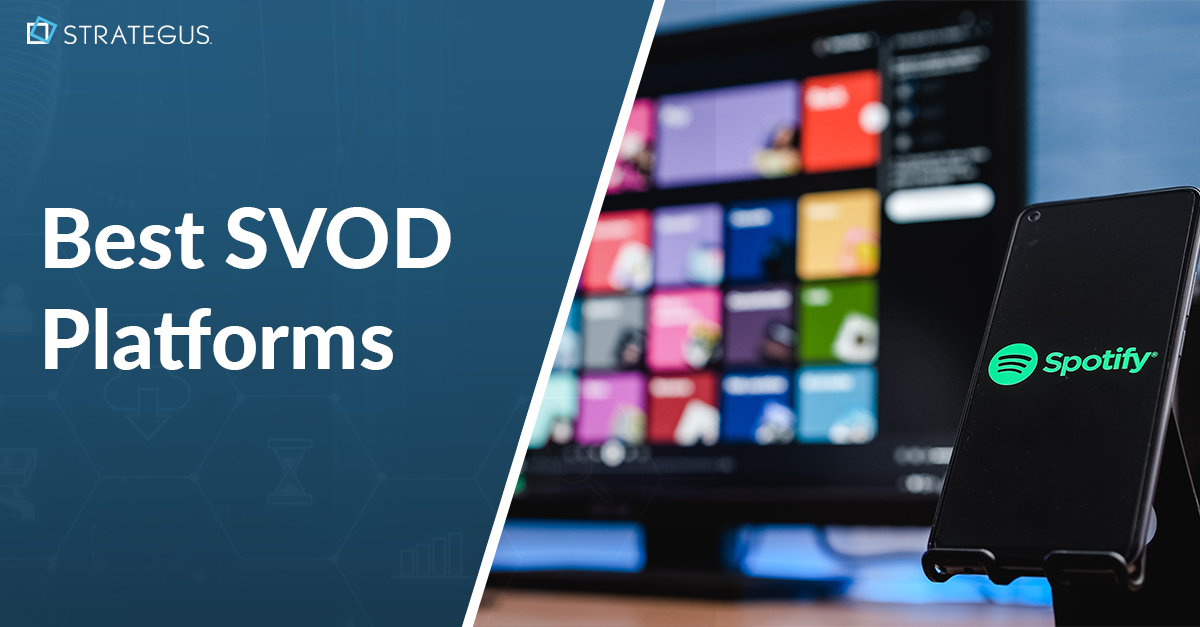- Home
- Strategus Blog
- Programmatic vs Non-Programmatic Advertising
Programmatic vs Non-Programmatic Advertising
9 minutes read

Advertising has evolved significantly over the years, with technology transforming the way brands reach their audiences. At the center of this transformation is programmatic advertising, an automated, data-driven approach to buying ad inventory in real time. In contrast, non-programmatic advertising relies on traditional, manual processes, including direct negotiations and fixed placement deals.
Each method has its strengths and limitations, making it essential for businesses to understand how they differ and when to use each. This article lists the key distinctions between programmatic and non-programmatic advertising, helping you determine which approach aligns best with your goals, budget, and resources. Whether you’re seeking efficiency and precision or a personalized touch, this guide will provide the insights you need to make an informed decision.
Key Takeaways
- Programmatic advertising automates ad buying with real-time bidding, advanced targeting, and data-driven optimizations, maximizing efficiency and ROI.
- Non-programmatic advertising uses manual processes for direct deals, offering premium placements, personalization, and strong publisher relationships.
- Programmatic excels in scalability, real-time optimization, and cross-device reach, while non-programmatic is better suited for high-profile or custom campaigns.
- Key differences include automation, precise audience targeting, cost-efficiency, and data insights in programmatic versus hands-on control in non-programmatic.
- Programmatic advertising is ideal for businesses seeking streamlined campaigns and measurable results, while non-programmatic fits specialized or brand-centric initiatives.
- Strategus simplifies programmatic advertising with fully managed services, delivering impactful results without operational challenges — start optimizing today.
What is Programmatic Advertising?
Programmatic advertising is an automated method of buying and selling digital ad inventory using sophisticated algorithms and real-time bidding. Unlike traditional ad-buying methods that involve manual negotiations and insertion orders, programmatic advertising streamlines the process by using software to purchase ad space automatically based on predefined targeting criteria.
This data-driven approach allows advertisers to reach their desired audience with unparalleled precision and efficiency while publishers benefit from increased revenue and better inventory management. Programmatic advertising encompasses various ad formats, including connected TV (CTV), display, video, mobile, and native ads, across multiple devices and platforms.
Benefits of Programmatic Advertising
Here are some benefits of the programmatic approach in the advertising industry.
Increased Efficiency and Time Savings
Programmatic advertising streamlines the ad-buying process, saving you valuable time and resources. Automated real-time bidding eliminates the need for manual negotiations and insertion orders, allowing you to focus on strategic campaign planning and optimization.
Enhanced Audience Targeting and Personalization
Programmatic platforms harness vast amounts of data to create detailed user profiles, enabling you to deliver highly personalized ads to your target audience. Advanced targeting options, such as demographic, behavioral, and contextual targeting, ensure your message reaches the right people at the right time, increasing ad relevance and engagement.
Learn More About Audience Targeting →
Improved Campaign Performance and ROI
Real-time optimization is a hallmark of programmatic advertising. Continuous analysis of campaign metrics allows for automatic adjustments to bid prices, ad placements, and targeting criteria, maximizing your return on investment. Programmatic platforms optimize your ad spend, ensuring you pay the optimal price for each impression based on its value to your target audience.
Access to Vast Ad Inventory
Programmatic advertising opens up a world of ad inventory across multiple platforms and formats. You can reach your audience through display, video, mobile, and connected TV on a wide range of websites and apps. This extensive reach allows you to connect with your target audience wherever they are in their online journey.
Learn More About Ad Inventory →
Cross-Device and Cross-Channel Reach
Programmatic advertising enables you to engage with your audience seamlessly across devices and channels. As users move between desktop, mobile, and connected TV, programmatic platforms ensure your ads follow them, providing a consistent and cohesive brand experience. This cross-device and cross-channel approach maximizes your campaign's impact and drives better results.
Learn More About Cross-Device Retargeting →
What is Non-Programmatic Advertising?
Non-programmatic advertising refers to the traditional method of purchasing ad inventory through direct negotiations between advertisers and publishers. In this manual process, advertisers work directly with publishers to secure ad placements, often involving fixed pricing and predetermined agreements.
Unlike programmatic advertising, which uses automation and real-time bidding, non-programmatic campaigns require human oversight to negotiate deals, select placements, and manage campaign execution.
This approach is commonly used for premium ad placements, such as sponsorships or exclusive homepage takeovers, where advertisers seek maximum visibility. While less efficient than programmatic, non-programmatic advertising allows for more control and personalization in ad placements.
Benefits of Non-Programmatic Advertising
Non-programmatic advertising offers unique advantages for advertisers seeking more control and direct relationships with publishers. While it may lack the automation of programmatic platforms, this traditional method provides benefits that are well-suited to certain campaigns and business needs.
Direct Relationships with Publishers
Non-programmatic advertising involves direct negotiations with publishers, fostering stronger relationships. This allows advertisers to secure premium placements, such as homepage takeovers or sponsored content, ensuring their brand stands out in high-visibility areas. These collaborations often lead to customized deals that align closely with campaign goals.
Full Control Over Placements
Advertisers have greater control over where their ads appear, making it easier to maintain brand safety and ensure placements align with their values. This control helps avoid issues like ads appearing next to inappropriate content, a concern sometimes associated with programmatic advertising.
Premium Placements for Brand Awareness
Non-programmatic campaigns often focus on high-impact placements, such as exclusive sponsorships or front-page banners. These premium placements are ideal for generating brand awareness and reaching large audiences during key moments, such as product launches or special events.
Tailored Campaign Strategies
The manual nature of non-programmatic advertising enables greater flexibility for tailored campaigns. Advertisers can work directly with publishers to create unique messaging or integrate their ads into specific editorial content, ensuring a more cohesive and engaging experience for the audience.
How Does Programmatic Advertising Differ from Non-Programmatic?
Programmatic advertising stands in stark contrast to traditional, non-programmatic methods in several key aspects. Understanding these differences is vital for making informed decisions about your advertising strategy and optimizing your campaigns for maximum impact and ROI.
Automation vs Manual Processes
One of the most significant differences between programmatic and non-programmatic advertising lies in the level of automation involved. Programmatic advertising relies heavily on advanced algorithms and machine learning to automate the ad-buying process, eliminating the need for manual negotiations and insertion orders. This automation streamlines the entire process, making it faster, more efficient, and less prone to human error.
In contrast, non-programmatic advertising involves manual processes at every stage, from identifying target audiences and negotiating ad placements to managing campaigns and optimizing performance. This hands-on approach can be time-consuming, resource-intensive, and less responsive to real-time changes in the advertising landscape.
Audience Targeting Capabilities
Programmatic advertising excels in its ability to target specific audiences with unparalleled precision. By leveraging vast amounts of data, including demographic, behavioral, and contextual information, programmatic platforms can create detailed user profiles that enable advertisers to deliver highly relevant ads to the right people at the right time.
Non-programmatic advertising, on the other hand, often relies on broader audience segments and less granular targeting options. While some level of targeting is possible, it lacks the sophistication and precision of programmatic methods, potentially leading to wasted ad spend on less relevant or engaged audiences.
Real-Time Optimization
Another key advantage of programmatic advertising is its ability to optimize campaigns in real-time based on performance data. Programmatic platforms continuously analyze campaign metrics and make automatic adjustments to bid prices, ad placements, and targeting criteria to ensure optimal performance and ROI.
Non-programmatic advertising, in contrast, typically involves a more static approach to optimization. Adjustments to campaigns are made manually and less frequently, often based on historical data rather than real-time insights. This can result in missed opportunities to capitalize on emerging trends or quickly adapt to changes in user behavior.
Cost Efficiency and ROI
Programmatic advertising offers significant advantages in terms of cost efficiency and return on investment (ROI). By automating the ad buying process and leveraging real-time bidding, programmatic platforms ensure that you pay the optimal price for each impression based on its perceived value to your target audience. This helps minimize wasted ad spend and maximize the impact of your advertising budget.
Non-programmatic advertising, while still effective in certain contexts, can be less cost-efficient due to its manual nature and less precise targeting capabilities. Without the benefit of real-time optimization and data-driven insights, non-programmatic campaigns may struggle to achieve the same level of ROI as their programmatic counterparts.
Programmatic vs Non-Programmatic Advertising: Which is Better?
Both programmatic and non-programmatic advertising have their merits, but programmatic has emerged as the more efficient and scalable option for modern businesses. While non-programmatic advertising allows for premium placements and hands-on control, it’s often time-intensive, requiring direct negotiations and manual management. This limits its scalability and can make it challenging for advertisers to optimize campaigns on the fly.
While non-programmatic may suit specific high-profile campaigns, programmatic advertising is the superior choice for businesses looking to streamline their efforts, improve targeting, and achieve greater returns on their ad spend. For those ready to harness the power of programmatic, Strategus offers a fully managed solution tailored to deliver impactful results.
How Does the Programmatic Ad Buying Process Work?
The programmatic ad buying process involves several key players and technologies working seamlessly to deliver targeted ads to the right audience at the right time. Understanding how this process works is essential for optimizing your campaigns and achieving maximum impact.
The Core Components: DSPs and SSPs
- Demand-Side Platforms (DSPs): These platforms are used by advertisers to automate the purchase of ad inventory. DSPs allow advertisers to set targeting criteria, bid prices, and budgets, ensuring ads reach the desired audience at an optimal cost.
- Supply-Side Platforms (SSPs): These platforms are used by publishers to manage and sell their ad inventory programmatically. SSPs connect publishers to multiple ad exchanges and DSPs, maximizing revenue by selling impressions to the highest bidder.
The Real-Time Bidding Process
- When a user visits a website or app, an ad request is sent to an ad exchange.
- The ad exchange initiates a real-time auction among advertisers using DSPs.
- DSPs place bids based on the impression’s value to their target audience.
- The highest bidder wins, and their ad is instantly served to the user.
This entire process occurs in milliseconds, ensuring a seamless experience for the user.
AI in Programmatic Advertising
Artificial intelligence (AI) has become a game-changer in the world of programmatic advertising, revolutionizing the way digital marketers approach targeting, optimization, and fraud prevention. As you navigate the programmatic landscape, understanding the impact of AI on your advertising efforts is key to staying ahead of the curve and maximizing your campaign performance.
AI-powered algorithms analyze vast amounts of data in real-time, identifying patterns and insights that would be impossible for humans to discern. This enables programmatic platforms to make split-second decisions about ad placements, bid prices, and targeting criteria, ensuring your ads reach the right audience at the optimal moment.
The Role of Data in Programmatic Advertising
- Data Management Platforms (DMPs): These platforms collect, organize, and analyze vast amounts of user data to create detailed profiles. This data informs targeting decisions, ensuring ads reach the most relevant audience.
- Real-Time Analytics: Advanced tools monitor campaign performance, offering insights into metrics like impressions, clicks, and conversions.
Dynamic Optimization for Better Results
As campaigns run, automatic adjustments are made to bid prices, ad placements, and targeting criteria based on performance data. This ensures campaigns consistently deliver the best possible results, maximizing ROI and minimizing waste.
Closing Thoughts - Is Programmatic Advertising Worth the Investment?
Programmatic advertising offers unmatched precision, efficiency, and scalability, making it an invaluable tool for businesses aiming to optimize their ad spend and achieve measurable results.
By automating ad buying and leveraging advanced targeting capabilities, programmatic enables you to reach the right audience at the right time. However, its complexity—requiring expertise in data management, real-time bidding, and ongoing optimization—can make it a challenge for businesses without specialized teams or resources.
That’s where Strategus comes in. We take the complexity out of programmatic advertising with our fully managed, hands-on approach. From strategy development and precise targeting to real-time optimization and detailed reporting, Strategus ensures your campaigns deliver maximum impact. With access to premium inventory and data-driven insights, we help your business achieve results without the operational headaches.
Don’t let the complexity of programmatic advertising hold you back. Contact us today today and access the full potential of your advertising campaigns.
Strategus is a managed services connected TV(CTV) advertising agency with over 60,000+ campaigns delivered. Find out how our experts can extend your team and drive the result that matter most.
Talk to an Expert
Seeking a Custom CTV Strategy That Delivers?
What to read next

Best SVOD Platforms for Advertisers
The streaming wars have a new battlefront, and this time, it's all about your ad budget. Just a few years ago, SVOD meant "no commercials." Now, it...
12 minutes read

Third-Party Data Targeting for CTV: Benefits & Tactics
Third-party data. It’s a term that’s thrown around, and yet few take the time to detail its pros and cons — much less strategies for using...
7 minutes read

First-Party Data Targeting: Benefits and Tactics for CTV Advertising
First-party data is the information that companies collect directly from their customers rather than through intermediaries. Advertisers use this...
10 minutes read

Foot-Traffic Attribution: Tying Ad Impressions to In-Store Visits
The marketing funnel has changed. Today’s shoppers often begin researching products from the comfort of their homes and don’t set foot into a store...
8 minutes read















